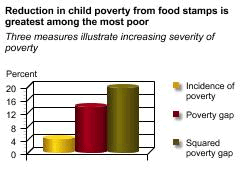Overview
Under the Food Assistance and Nutrition Research Program
(FANRP), ERS conducts research on the outcomes of the
Nation's domestic food
assistance and nutrition programs, including the Food
Stamp Program, the Special
Supplemental Nutrition Program for Women, Infants, and
Children (WIC), and the child
nutrition programs. These programs aim to reduce food
insecurity, provide access to nutritious diets, and supply
indirect economic support to needy families. ERS research
on program outcomes (that is, the effects of the programs
on participants) provides a measure of how well the programs
are meetings these goals.
This research can be divided into four main categories:
Features
Food
Assistance and Obesity: Measuring the Link—ERS hosted a workshop in July 2007 for researchers to discuss the merits of different data sets and methodologies in food assistance and obesity research. Discussion goals included sharing recent findings from ongoing and completed studies, increasing awareness of common empirical challenges and how to address them in obesity and food assistance studies, identifying research gaps, and identifying variables to add to survey instruments. For an agenda of the workshop with presentation titles, contact Katherine Ralston.
Issues in
Food Assistance-Effects of WIC Participation on Children's
Food Consumption—This study compared consumption
patterns of WIC children with those of three different
comparison groups: eligible nonparticipating children
living in non-WIC households, eligible nonparticipating
children living in WIC households, and children living
in households with income too high to be eligible for
WIC. The study provides strong evidence that participation
in the WIC program increases consumption of at least some
types of WIC-approved foods.
Effects of Food Assistance
and Nutrition Programs on Nutrition and Health: Volume
4, Executive Summary of the Literature Review, December
2004—This report summarizes a comprehensive review
and synthesis of published research on the impact of
USDA's
domestic food assistance and nutrition programs on participants'
nutrition and health outcomes. The outcome measures
reviewed
include food expenditures, household nutrient availability,
dietary intake, other measures of nutrition status,
food
security, birth outcomes, breastfeeding behaviors, immunization
rates, use and cost of health care services, and selected
nonhealth outcomes, such as academic achievement and
school performance (children) and social isolation
(elderly).
The report is one of four volumes produced by a larger
study that includes Research Design (Volume 1), Data
Sources
(Volume 2), and Literature Review (Volume 3).
Recommended Readings
Food
Stamps and Obesity: Ironic Twist or Complex Puzzle?
February 2006—This article examines the relationship
between Food Stamp Program participation and body weight.
In contrast to earlier years, recent data show that women
who receive food stamps are no more likely to be overweight
or obese than eligible nonparticipating women or those
with low to moderate incomes. The relationship between
program participation and weight is also examined by age,
sex, race, and ethnicity.
Nutrient Adequacy of Children
Participating in WIC, April 2006—USDA’s
Special Supplemental Nutrition Program for Women, Infants,
and Children (WIC) provides supplemental foods to participants,
in most cases through vouchers for retail purchase of
foods designated as approved by the program. WIC food
packages were initially designed to include foods rich
in nutrients that were lacking in the diets of low-income
participants. This brief summarizes two recent ERS-sponsored
studies that provide new assessments of nutrient intakes
of WIC children, income-eligible children not participating
in the program, and children ineligible for the program.
The USDA Fruit
and Vegetable Pilot Program Evaluation, November 2004—The
Fruit and Vegetable Pilot Program for the 2002-03 school
year provided fresh and dried fruits and fresh vegetables
free to children in 107 elementary and secondary schools—100
schools in 4 States (25 each in Indiana, Iowa, Michigan,
and Ohio) and 7 schools in the Zuni Indian Tribal Organization
in New Mexico. The pilot was popular among most students,
parents, school teachers, principals, pilot managers,
foodservice staff, and State representatives. Schools
reported that 80 percent of students were very interested
in the pilot and 18 percent were somewhat interested;
71 percent of the schools believed that students’
interest had increased during the pilot period.
See all recommended readings…
Recommended Data Products
FANRP
Project Database—Provides details on FANRP research
projects, both completed and ongoing, including the project's
objective, funding level, researchers, and expected completion
date.
National
Data Useful in Food Assistance and Nutrition Research—Brief
descriptions of National surveys and data sets with links
to their sources. The following three surveys are particularly
useful for analyzing program outcomes:
- Current Population
Survey (CPS) Food Security Supplement data—Annual
data on food expenditures, food security, and use of
food assistance programs and other strategies for coping
with or ameliorating food deprivation.
- Survey of Program
Dynamics (SPD), Food Security Status file, data, and
technical documentation—The SPD was designed
specifically to monitor and assess outcomes of welfare
program changes begun in 1996. It includes questions
on a broad array of topics including income, employment,
use of food assistance and nutrition programs, and receipt
of cash welfare. ERS prepared a food security status
file to facilitate analysis of food security in households
interviewed in the SPD.
- The Panel
Study of Income Dynamics (PSID) data—The PSID
is an ongoing longitudinal survey, begun in 1968, of
a representative sample of U.S. individuals and their
families. It contains data on participation in the Food
Stamp Program, WIC, and Reduced Cost Meals, as well
as information on food security and healthy eating habits.
Recent Research Developments
Methodology To Evaluate
the Outcomes of the Team Nutrition Initiative in Schools,
June 2006—This project develops a data collection
methodology to evaluate outcomes of Team Nutrition, a
voluntary USDA school-based initiative to promote nutrition
education, healthy eating, and physical activity. The
project uses information technology to collect high-quality
data while decreasing respondent and investigator burden
and lowering data collection and analysis costs. Seven
data collection instruments were developed: five collect
information from school personnel, one collects information
from students, and the seventh is an on-site observation
of the school environment. The pilot test and methodology
could be instructive and adapted by other States.
Related Links
Food and Nutrition
Information Center (FNIC)—One of several information
centers at USDA's National Agricultural Library. Access
all of FNIC's resource lists and databases, as well as
many other food- and nutrition-related links.
Food and Nutrition
Service—Administers USDA's food assistance programs
and provides program guidelines, data, and research on
the Food Stamp
Program, WIC,
and child nutrition
programs.
Office of
the Assistant Secretary for Planning & Evaluation (ASPE)—Information
on program "leavers" and other studies of welfare
outcomes.
Images Gallery
Food
assistance and nutrition programs at a glance—Charts,
tables, and data on food stamps, WIC, child nutrition
programs, child poverty, and more.

|



